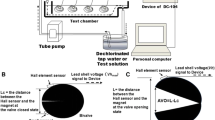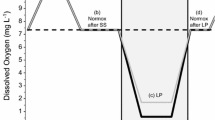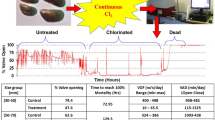Abstract
Freshwater mussels are at-risk taxa and may be exposed to high levels of carbon dioxide (CO2) because of the potential use of CO2 to control the movement of invasive aquatic fish species. One potential behavioral response to a change in the partial pressure of CO2 (pCO2) may be altered valve movement. In this study, three species of mussels were fitted with modified sensors and exposed to two regimes of pCO2 to define thresholds of impaired valve movement. The first experiment demonstrated that Pyganodon grandis were much more tolerant to rising pCO2 relative to Lampsilis siliquoidea (acute closure at ∼200,000 μatm in comparison to ∼80,000 μatm). The second experiment consisted of monitoring mussels for 6 days and exposing them to elevated pCO2 (∼70,000 μatm) over a 2-day period. During exposure to high pCO2, Lampsilis cardium were open for nearly the entire high pCO2 period. Conversely, P. grandis were closed for most of the period following exposure to high pCO2. For L. siliquoidea, the number of closures decreased nearly 40-fold during high pCO2. The valve movement responses observed suggest species differences, and exposure to elevated pCO2 requires a reactive response.



Similar content being viewed by others
References
Bolker BM, Brooks ME, Clark CJ et al (2009) Generalized linear mixed models: a practical guide for ecology and evolution. Trends Ecol Evol 24:127–135. doi:10.1016/j.tree.2008.10.008
Breslow NE, Clayton DG (1993) Approximate inference in generalized linear mixed models. J Am Stat Assoc 88:9–25
Butman D, Raymond PA (2011) Significant efflux of carbon dioxide from streams and rivers in the United States. Nat Geosci 4:839–842. doi:10.1038/ngeo1294
Byrne RA, Gnaiger E, McMahon RF, Dietz TH (1990) Behavioral and metabolic responses to emersion and subsequent reimmersion in the freshwater bivalve, Corbicula fluminea. Biol Bull 178:215–259
Campbell DC, Serb JM, Buhay JE et al (2005) Phylogeny of North American amblemines (Bivalvia, Unionoida): prodigious polyphyly proves pervasive across genera. Invertebr Biol 124:131–164. doi:10.1111/j.1744-7410.2005.00015.x
Clingerman J, Bebak J, Mazik PM, Summerfelt ST (2007) Use of avoidance response by rainbow trout to carbon dioxide for fish self-transfer between tanks. Aquac Eng 37:234–251. doi:10.1016/j.aquaeng.2007.07.001
Cole JJ, Caraco NF, Kling GW, Kratz TK (1994) Carbon dioxide supersaturation in the surface waters of lakes. Science 265:1568–1570
Cooper JE (2011) Anesthesia, analgesia, and euthanasia of invertebrates. ILAR J 52:196–204
Crawford JT, Stanley EH, Dornblaser MM, Striegl RG (2016) CO2 time series patterns in contrasting headwater streams of North America. Aquat Sci. doi:10.1007/s00027-016-0511-2
Cummings KS, Mayer CA (1992) Field guide to freshwater mussels of the Midwest. Illinois Natural History Survey Manual 5
Cupp AR, Erickson RA, Fredricks KT, et al. (2017) Responses of invasive silver and bighead carp to a carbon dioxide barrier in outdoor ponds. 305:297–305.
Donaldson MR, Amberg JJ, Adhikari S et al (2016) Carbon dioxide as a tool to deter the movement of invasive bigheaded carps. Trans Am Fish Soc 145:657–670. doi:10.1080/00028487.2016.1143397
Dowd WW, Somero GN (2013) Behavior and survival of Mytilus congeners following episodes of elevated body temperature in air and seawater. J Exp Biol 216:502–514. doi:10.1242/jeb.076620
Famme P (1980) Effect of shell valve closure by the mussel Mytilus edulis L. on the rate of oxygen consumption in declining oxygen tension. Comp Biochem Physiol 67A:167–170
Hannan KD, Jeffrey JD, Hasler CT, Suski CD (2016a) Physiological responses of three species of unionid mussels to intermittent exposure to elevated carbon dioxide. Conservation Physiology 4:1–13. doi:10.1093/conphys/cow066
Hannan KD, Jeffrey JD, Hasler CT, Suski CD (2016b) The response of two species of unionid mussels to extended exposure to elevated carbon dioxide. Comp Biochem Physiol -Part A Mol Integr Physiol 201:173–181. doi:10.1016/j.cbpa.2016.07.009
Hannan KD, Jeffrey JD, Hasler CT, Suski CD (2016c) Physiological effects of short- and long-term exposure to elevated carbon dioxide on a freshwater mussel, Fusconaia flava. Can J Fish Aquat Sci 73:1538–1546. doi:10.1139/cjfas-2016-0083
Hasler CT, Butman D, Jeffrey JD, Suski CD (2016) Freshwater biota and rising pCO2? Ecol Lett 19:98–108. doi:10.1111/ele.12549
Jeffrey JD, Hannan KD, Hasler CT, Suski CD (2016) Molecular and whole-animal responses to elevated CO2 exposure in a freshwater mussel. J Comp Physiol B 187:87–101. doi:10.1007/s00360-016-1023-z
Johnson MS, Billett MF, Dinsmore KJ et al (2009) Direct and continuous measurement of dissolved carbon dioxide in freshwater aquatic systems—method and applications. Ecohydrology 3:68–78. doi:10.1002/eco.95
Kroeker KJ, Kordas RL, Crim RN, Singh GG (2010) Meta-analysis reveals negative yet variable effects of ocean acidification on marine organisms. Ecol Lett 13:1419–1434. doi:10.1111/j.1461-0248.2010.01518.x
Markich SJ, Brown PL, Jeffree RA, Lim RP (2000) Valve movement responses of Velesunio angasi (Bivalvia: Hyrdiidae) to manganese and uranium: an exception to the free ion activity model. Aquat Toxicol 51:155–175
McCorkle S, Shirley TC, Dietz TH (1979) Rhythms of activity and oxygen consumption in the common pond clam, Ligumia subrostrata (Say). Can J Zool 57:1960–1964
Nagai K, Honjo T, Go J et al (2006) Detecting the shellfish killer Heterocapsa circularisquama (Dinophyceae) by measuring bivalve valve activity with a Hall element sensor. Aquaculture 255:395–401. doi:10.1016/j.aquaculture.2005.12.018
Noatch MR, Suski CD (2012) Non-physical barriers to deter fish movements. Environ Rev 20:1–12. doi:10.1139/A2012-001
Norton-Griffiths M (1967) Some ecological aspects of the feeding behaviour of the oystercatcher Haematopus ostralegus on the edible mussel Mytilus edulis. Ibis 109:412–424
Pennak RW (1989) Fresh-water invertebrates of the United States: protozoa to mollusca, 3rd edn. Wiley, New York
Phillips J, McKinley G, Bennington V et al (2015) The potential for CO2-induced acidification in freshwater: a Great Lakes case study. Oceanography 25:136–145. doi:10.5670/oceanog.2015.37
R Development Core Team (2010) R: a language and environment for statistical computing, Vienna, Austria. URL http://www.R-project.org/
Reynaud S, Leclercq N, Romaine-Lioud S et al (2003) Interacting effects of CO2 partial pressure and temperature on photosynthesis and calcification in a scleractinian coral. Glob Chang Biol 9:1660–1668
Ricciardi A, Rasmussen JB (1999) Extinction rates of North American freshwater fauna. Conserv Biol 13:1220–1222
Robson AA, Garcia De Leaniz C, Wilson RP, Halsey LG (2010) Behavioural adaptations of mussels to varying levels of food availability and predation risk. J Molluscan Stud 76:348–353. doi:10.1093/mollus/eyq025
Robson AA, Thomas GR, Garcia De Leaniz C, Wilson RP (2009) Valve gape and exhalant pumping in bivalves: optimization of measurement. Aquat Biol 6:191–200. doi:10.3354/ab00128
Robson AA, Wilson RP, Garcia de Leaniz C (2007) Mussels flexing their muscles: a new method for quantifying bivalve behaviour. Mar Biol 151:1195–1204. doi:10.1007/s00227-006-0566-z
Romero LM, Dickens MJ, Cyr NE (2009) The reactive scope model—a new model integrating homeostasis, allostasis, and stress. Horm Behav 55:375–389. doi:10.1016/j.yhbeh.2008.12.009
Salánki J (1963) The effect of serotonin and catecholamines on the nervous control of periodic activity in fresh-water mussel (Anodonta cygnea). Comp Biochem Physiol 8:163–171
Schick JM, Gnaiger E, Widdows J et al (1986) Activity and metabolism in the mussel Mytilus edulis L. during intertidal hypoxia and aerobic recovery. Physiol Biochem Zool 59:627–642
Schick JM, Widdows J, Gnaiger E (1988) Calorimetric studies of behavior, metabolism and energetics of sessile intertidal animals. Am Zool 28:161–181
Strayer D, Downing J, Haag W et al (2004) Changing perspectives on pearly mussels, North America’s most imperiled animals. Bioscience 54:429–439
Strayer DL, Dudgeon D (2010) Freshwater biodiversity conservation: recent progress and future challenges. J North Am Benthol Soc 29:344–358. doi:10.1899/08-171.1
Summerfelt ST, Sharrer MJ (2004) Design implication of carbon dioxide production within biofilters contained in recirculating salmonid culture systems. Aquac Eng 32:171–182
Therneau T (2015) A package for survival analysis in S. R package version 2.38, https://CRAN.R-project.org/package=survival
Torsten H, Bretz F, Westfall P (2008) Simultaneous inference in general parametric models. Biom J 50:346–363
Vaughn CC, Nichols SJ, Spooner DE (2008) Community and foodweb ecology of freshwater mussels. J North Am Benthol Soc 27:409–423. doi:10.1899/07-058.1
Widdicombe S, Spicer JI (2008) Predicting the impact of ocean acidification on benthic biodiversity: what can animal physiology tell us? J Exp Mar Bio Ecol 366:187–197. doi:10.1016/j.jembe.2008.07.024
Williams JD, Warren ML, Cummings KS et al (1993) Conservation status of freshwater mussels of the United States and Canada. Fisheries 18:6–22. doi:10.1577/1548-8446(1993)018<0006:csofmo>2.0.co;2
Wilson R, Reuter P, Wahl M (2005) Muscling in on mussels: new insights into bivalve behaviour using vertebrate remote-sensing technology. Mar Biol 147:1165–1172. doi:10.1007/s00227-005-0021-6
Zandee DI, Holwerda DA, Kluytmans JH, De Zwaan A (1985) Metabolic adaptations to environmental anoxia in the intertidal bivalve mollusc Mytilus edulis L. Netherlands J Zool 36:322–343
Zuur AF, Ieno EN, Walker N et al (2009) Mixed effects models and extensions in ecology with R. Springer, New York
Acknowledgements
This work was supported by the Illinois Department of Natural Resources, and the United States Geological Survey, through funds provided by the United States Environmental Protection Agency’s Great Lakes Restoration Initiative. J. Tiemann, K. Cummings, J. Tix, C. Sullivan, and J. Sherwood provided valuable help collecting mussels. We would also like to thank A. Wright for providing valuable help with mussel husbandry and laboratory assistance.
Author information
Authors and Affiliations
Corresponding author
Additional information
Responsible editor: Philippe Garrigues
Rights and permissions
About this article
Cite this article
Hasler, C.T., Hannan, K.D., Jeffrey, J.D. et al. Valve movement of three species of North American freshwater mussels exposed to elevated carbon dioxide. Environ Sci Pollut Res 24, 15567–15575 (2017). https://doi.org/10.1007/s11356-017-9160-9
Received:
Accepted:
Published:
Issue Date:
DOI: https://doi.org/10.1007/s11356-017-9160-9




